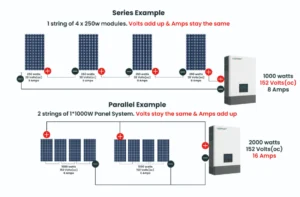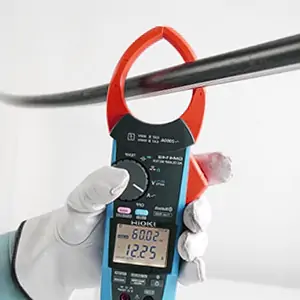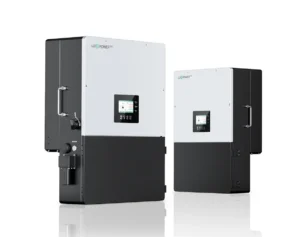Introduction
Solar energy has revolutionized our lives. Clean energy. Fast and efficient production. Above all, it is far cheaper and easier to grab than other energy solutions. But the problem erupts when you need to know your power needs at home.
Are you stuck on selecting power requirements? Well, this guide is for you. We will dive deep and answer your question: How to calculate solar panel battery and inverter? Let’s shine a light on this aspect.
Why should you adopt sustainable solar energy?

Solar energy is the talk of the town. Do you know why? Because it has provided humans with shelter and unlimited energy resources. It is economical and offers a clean source.
Here are a few points that help you think about this energy source!
1) Never-ending energy resource
There is no need to consider biomass or fossil fuels for energy production. Sunlight has been coming to Earth for millions of years and will never end.
Take a share of energy and switch on your devices. Such an endless source of energy wipes out fear!
2) Eco-friendly
Solar energy is 100% clean and doesn’t harm the environment. There is no soil erosion or deforesting involved. You must install a few solar plates, capture sunlight, and produce the energy. It keeps on delivering for years without affecting the natural environment.
3) Cost-saving
Forget the elevated electricity cost. Reduce your bills and save more money with solar energy. There is no governmental control over such natural resources. Moreover, the cost of solar panels is relatively low. It is a one-time investment for the next 20-25 years. Such a solution keeps your high energy production at the lowest possible costs. Save more bucks and enjoy benefits in the long run.
4) Easily Accessible
Do you have a flat roof? It doesn’t matter if you have a flat or curved roof. Recent trends of flexible solar panels have brushed off this concern. Shape the solar plates in up to 180 degrees without investing more money.
Install solar panels and start producing unlimited energy. Such accessibility is available to everyone without affecting others. Some commercial sectors even run factories and significant appliances on such a renewable energy source.
How to calculate solar panel battery and inverter?

Kickstart your battery and inverter calculation with the power requirements. It depends on where you are installing your panels. For example, a home needs less power compared to a factory.
Similarly, appliances also matter when choosing the right power system. We will close the whole discussion in five detailed steps.
Step 1: Calculate your Load
There are two critical methods for calculating your load. It depends on where you are starting. If you have a clamp meter, the job is effortless. You can directly get reading from the electric meters after turning on your all devices.
Sometimes, the device’s power rating plays a crucial role.
Let’s unfold both methods.
(1)Power Rating
Different devices use different powers, which can be either peak or continuous. For example, a laptop can use around 50-60 watts. Similarly, a mini-fridge consumes 50 watts of power. A smartphone can charge at 10-20 watts.
How do you check the power rating?
- Some devices, such as smartphone chargers, have written wattage on them. Thoroughly go through it.
- If you have a manufacturer’s manual, that works out well.
- Those who fail to explore both methods can find it online.
Here is the list of home devices with their power rating.
With the power rating, you can sum up all your data. For example, you are charging the following devices.
- A laptop of 50 watts.
- A ceiling fan of 50 watts.
- The washing machine is 300 watts.
The total load will be the sum of all the three tools.
50W+50W+300W = 400W
In addition, you can also make a statistical table to make statistics on the electrical equipment in your home, such as the table below.
| Appliance | Qty | Power Rating | Hours used/day | Watts Hours/day |
| Ceiling Fan | 5 | 100 | 8 | 4000 |
| Refrigerator | 2 | 300 | 8 | 4800 |
| Lighting Point | 1 | 600 | 12 | 7200 |
| Computer | 1 | 25 | 8 | 200 |
| Monitor | 2 | 15 | 12 | 360 |
| Television | 1 | 75 | 4 | 300 |
| VCR | 1 | 150 | 4 | 600 |
| Radio | 1 | 80 | 4 | 320 |
| Iron | 1 | 1000 | 0.3 | 300 |
| Total | 18080 Watts | |||
(2)Using Clamp Meter

A clamp meter is another best option. But it is suitable when:
- You don’t know the power rating.
- A clamp meter is available in your den.
Measuring power with a clamp meter can be fun and fast. It tells you the power in amperes. Multiply your given clamp meter reading with the voltage.
For example, the clamp meter reading is 10A. The voltage is 220 Volts.
Total power = 250 Volts x 4 A
Total power = 1000 Watts
But there is one con. You can’t calculate the power of each device individually. The clamp meter gets readings from the electric meters. So, it is the total power consumption of all of your devices.
Step 2: How much is the Backup time?
Backup time is the appliance running time on your battery. For example, you have a mini-fridge with 50 watts of power. Suddenly, the power cuts off. Now, the time battery is providing all the power to the mini-fridge.
How many hours does it turn on the battery storage? If it works for 5 hours, this time is the backup. A higher backup time can also indicate battery power. It impacts the energy capacity. Large battery capacity means you can run devices nonstop for hours.
At such a point, set up your demands for the backup supply. Then, calculate the total battery storage you need.
For example, if you need a constant power supply for 5 hours to empower your devices.
First, calculate the device’s power using the power rating or clamp meter method. Suppose it is 1000 watts. Now, calculate the battery storage you need for the device to run for 5 hours.
Battery Storage = Total Load * Backup Time
= 1000 Watts x 5 hours.
= 5000Wh
Now, you need 5000 watts of battery storage.
Step 3: Calculate Battery Capacity

Measuring the battery capacity can help determine how many batteries you need for a 5000-watt power load.
There are two types of batteries commonly being used.
Lead Acid Battery
These are dominating the home sectors. Usually, one 150 ah can store an energy of 1800 watt-hours.
Capacity = 12 volts × 150 Ah = 1,800 watt-hours (Wh)
Batteries required backup time power /capacity.
Batteries required= 5000 watt-hours / 1800 watt-hours = 2.77≈ 3 lead-acid batteries
You would need at least three lead-acid batteries to empower your system.
Lithium-ion batteries.
These batteries are trending because of their excellent power supply and the few accident cases.
You can apply the above scenario to lithium-ion batteries. You might need one 150-ah battery. Here is the complete calculation of the data.
Capacity = 48 volts × 150 Ah = 7,200 watt-hours (Wh)
Batteries required= backup time power /capacity
Batteries required= 5000 watt-hours/ 7200 watt-hours = 0.69≈ 1 lithium-ion battery
One lithium-ion battery can meet your whole power supply demands.
Step 4: Calculate Inverter Capacity
Have you ever wondered about inverters? They are necessary because solar energy storage is in DC form, while home appliances work at AC voltage.
Convert your DC into AC to meet your demands and turn on your devices.
To know the inverter capacity, you must know the total power load. Voltage and current calculations can also be an alternative.
First, calculate the power tolerance. It is often 20-25% of the total power load.
Suppose the above example of a power load. 5000 watts is the power load. The tolerance will be.
Tolerance = 1000 watt x 20/100 = 200 watts
The total power tolerance is 1000 watts. Now, calculate the inverter capacity for your required power load.
Inverter Capacity= Load + tolerance = 1000 watts + 200 watts = 1200 watts
You would need at least an inverter with 1.2kWh capacity. The capacity below this level can’t empower devices efficiently.
Step 5: Calculate Panel Capacity

Finally, you can calculate the total power needed for the solar panels. Remember, solar panels don’t offer 100% efficiency in solar energy production. So, we’ll rely only on 80% of the output.
Let’s determine how many solar panels there are and what power you need.
-
Total power with backup time required.
We have already discussed it as being 5000 watt-hours.
-
Calculation solar of 80% efficiency.
If the efficiency is 80%, then you can calculate it.
Power load with backup time ÷ efficiency
=5000 watt-hours ÷ 80/100
=6250 watt-hours
-
Hours for sunlight they are charging.
Sunlight availability is necessary for solar panel charging. Not all solar panels remain in sunlight for 24 hours so that we will assume a value of 5 hours here.
-
Required panel capacity
Once you have the sunlight timing, it is a no-brainer to calculate the solar panel capacity.
Solar panel capacity = 6250 Wh ÷ 5 hours = 1250 watts
Your solar panel capacity must be 1250 watts. You can use 100 watts, 200 watts, or even more wattage, but multiply the number of panels with the power. The total solar panel capacity must be equal to or sometimes greater than the required one.
Conclusion
A blind jump into solar technology can dump you down! So, relax. Understand all your power requirements at home or in commercial sectors. Measure how much power you need. Finally, you can explore the relevant solar solutions.
If you want premium-quality solar solutions, we have them. Lux Powertek has all the solar solutions. Expect nothing but world-class quality and productivity. Check out the latest solutions now!


